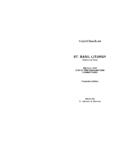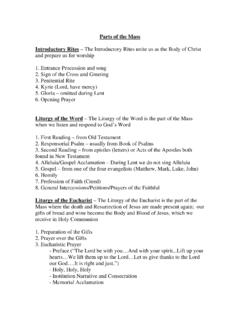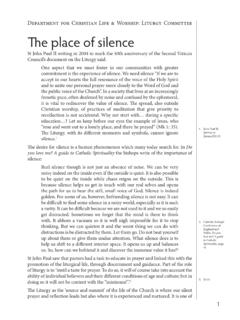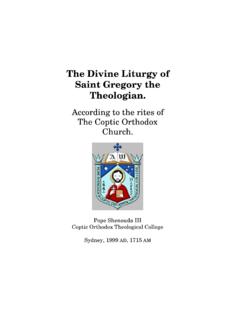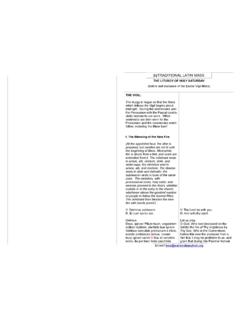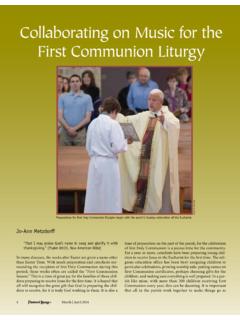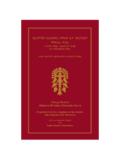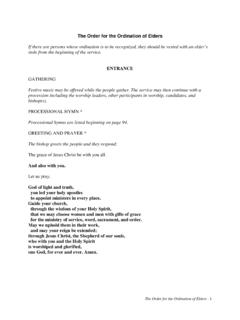Transcription of Re-visioning the Good Friday Liturgy - Frank …
1 1 Re-visioning the good Friday Liturgy J. Frank Henderson Frank Henderson s Page on Liturgy and Medieval Women J. Frank Henderson 2001 Contents Outline of the good Friday Liturgy Full Participation Gathering Opening Prayer First Reading Psalm Second Reading Gospel Homily and Song Solemn Prayers / General Intercessions Veneration of the Cross Communion Other Services 2 Critical studies of the good Friday Liturgy (listed below) raise a number of questions, concerns and issues regarding this important Liturgy . Here I note additional concerns regarding this Liturgy and suggest some possible revisions. More obviously needs to be done.
2 This is one of a series of studies of the good Friday Liturgy . The others are: Critical Reflections on the Passion Narrative of the good Friday Liturgy Critical Reflections on the Reproaches of the good Friday Liturgy Critical Reflections on the good Friday Liturgy : Anti-Judaism, Paschal Character, Relationship to Passion Sunday, Soteriology, Christology, and the Preeminence of John Veneration of the Cross ( good Friday ): Alternative Models Unless specified otherwise, this discussion has to do with the Roman Catholic Liturgy of good Friday and the Roman Catholic Church. Outline of the good Friday Liturgy For the sake of clarity, an outline of this Liturgy is provided. Its official title is The Celebration of the Lord s Passion. Opening Prayer Liturgy of the Word First Reading: Isaiah 52-13 53:12 Responsorial Psalm: Psalm 31:2, 6, 12-13, 15-16, 17, 25 Second Reading: Hebrews 4:14-16; 5:7-9 Verse: Philippians 2:8-9 Gospel: John 18:1 18:42 General Intercessions or Solemn Prayers For the church; For the pope; For the clergy and laity of the church; For those preparing for baptism; For the unity of Christians; For the Jewish people; For those who do not believe in Christ; For those who do not believe in God; For all in public office; For those in special need Veneration of the Cross (With various musical texts, including the Reproaches.)
3 3 Holy Communion Prayer after communion Prayer over the people Full Participation The central principle of the contemporary liturgical renewal, according to Vatican Council II, is that full, conscious and active participation is the right and responsibility of all; this is based on their baptism (Constitution on the Liturgy , n. 14). In addition, liturgical celebrations ought to be fruitful in the lives of those who participate (Constitution on the Liturgy , n. 11). The good Friday Liturgy provides less opportunity for such full participation than does the regular Sunday eucharist. It remains quite traditional in shape and expression, and therefore is relatively clerical. Among other things, there is little singing by the assembly (only during the psalm, gospel verse, and veneration of the cross).
4 At the parish level, many attempts have been made to increase participation some more successfully than others but these have not received official endorsement. Participation, of course, is not entertainment, and it is not a matter of giving people something to do. But fostering full participation is not an option, either. Liturgical participation has an ecclesiological dimension in that it demonstrates that the Liturgy is an action of the church, and that the church is the entire liturgical assembly, not just the clergy. It also allows the assembly and its individual members to enter into the liturgical action more deeply and completely and allows the people/church to express themselves liturgically more fully. Certainly silence and looking are legitimate modes of liturgical participation, and these are prominent in the good Friday Liturgy . Musical participation, however, is minimal, though today this has in general become a particularly significant form of lay participation.
5 Music for the good Friday Liturgy needs to be chosen with great care, whether simply the other suitable songs for the veneration of the cross, or additional songs suggested here. The mood of such songs needs to be consistent with the overall mood of the Liturgy : not gloomy, but nonetheless solemn. They should not contain anti-Jewish content, the should be paschal, and the soteriology they express should be appropriate. Some songs traditionally used during Holy Week and on good Friday unfortunately do not meet these criteria. 4 Gathering At present the good Friday Liturgy begins in silence, with the presbyter entering in silence and kneeling or prostrating himself in silent prayer. He then rises and begins the opening prayer. The people pray silently after the invitation, Let us pray (if they are given time to do so); their first verbal participation is the Amen at the end of the opening prayer.
6 An addition that would give expression to the role of the entire assembly as subject of the liturgical action would be to have an opening song. This could be solemn and restrained, in keeping with the overall mood of the good Friday Liturgy , and it could be more a meditative experience rather than a processional song. Opening Prayer The present two texts for the opening prayer are criticized for being inadequately paschal in character and for enunciating solely an anselmian soteriology. In addition, the petition is either weak ( make us holy and watch over us always ) or somewhat unclear in meaning: ( help us to put on the likeness of our Lord in heaven. ) Finally, this prayer might use a stronger and more appropriate image of God in its address (compared to the present Lord ). Of course it would also avoid anti-Judaism and use inclusive language. One concrete alternative is simply to use the present prayer after communion as opening prayer, though this text too could be improved.
7 You have restored us to life by the triumphant death and resurrection of Christ. Continue this healing work within us. May we who participate in this mystery never cease to serve you .. New texts also need to be composed. First Reading The present first reading is Isaiah 52:13 - 53:12, the Fourth Servant Song. Questions have been raised regarding this text from the perspectives of anti-Judaism and of soteriology. 5 One approach to the selection of alternative texts for the first reading is as follows. Jesus, in his suffering, death and resurrection, stands in a long line of faithful Jews who have suffered but have also been rescued or vindicated by God. This approach honors the Jewishness of Jesus; it also accepts the biblical texts first of all, as Israel s stories, which are also those of the Jewish Jesus.
8 This approach does not consider the first reading in a typological sense (though that mode of interpretation might be thrust upon it by some). It attempts rather to respect the character and integrity of the Hebrew Scriptures, and to see continuity (rather than discontinuity) between Jesus and his forebears. The following are examples of texts that might be used in this way. Genesis 21:8-19. Hagar and her son are sent into the desert, and God comes to their aid. Genesis 22:1-15. Abraham and Isaac go to present a burnt offering, and God comes to their aid. Genesis 37:2-35. Joseph is left to die, but is rescued. Jeremiah 37:1-22; 38:1-16 (or portions thereof). Jeremiah is imprisoned, but released. Daniel 13 (Susanna). Susanna is unjustly accused and almost executed, but God comes to her aid. A second approach is to let the first reading interpret the johannine passion narrative to highlight a message that is already implicit there and which is developed more explicitly elsewhere in John s gospel.
9 This is the theme of re-birth and becoming children of God. Jesus death on the cross is seen as death in childbirth, giving birth to the church and to God s children in the Spirit. Appropriate first readings might include the following: Genesis 35:9-20. Rachel dies giving birth to Benjamin. 1 Samuel 4:1-22. The wife of Phineas dies in childbirth and the ark of God is captured. These stories are respected for their own sake, but they also guide participants interpretation of the passion narrative. Both approaches are also ways of bringing women s stories to the good Friday Liturgy . 6 Psalm The present text uses selections from Psalm 31, and could be kept. An alternative, chosen for the Revised Common Lectionary, is Psalm 22. Another alternative would be Isaiah 38:9-30, the song of Hezekiah.
10 Second Reading The present second reading is Hebrews 4:14-16; 5:7-9. Questions have been raised regarding this text from the perspectives of anti-Judaism, soteriology, and regarding its paschal character. In addition, it might be better to use a coherent passage rather than several snippets. One alternative is to follow the Revised Common Lectionary in using Hebrews 10:16-25. A second alternative, which would effectively express the paschal character of this Liturgy , is to use the same reading that is used at the Easter Vigil, namely: Romans 6:3-11. Baptized in the death and resurrection of Jesus. A third alternative is to use other passages that explicitly link death and resurrection (and use diverse soteriological images as well). The following are possible readings: Romans 8:18-39 (or 31-39). Christ died, was raised, and makes intercession for us 1 Corinthians 15:3-28 (or 20-28). Christ was raised from the dead.. the first fruits of those who have fallen asleep.
